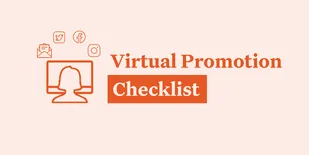Mindbody Checklist
How to Promote Your Virtual Fitness Offerings with Social Media and Email Marketing
Last updated: August 6, 2025

Checklist
As virtual services become an integral part of fitness businesses, it's important to consider how you'll position your virtual brand—and promote it—across various online platforms. More than ever, your social media and email marketing efforts are key to reaching new customers, engaging with existing ones, and bringing back those who may've dropped off. And while it's easy to start off strong, the real challenge is developing a long-term plan. This checklist will help you do just that—sustainably position your virtual brand with the help of social media and email marketing.
Put systems in place
Developing a system will increase the likelihood of success. Here's how to get started:
- Define goals. For social media, these goals will depend on the platforms you use and if you decide to invest in social ads. For email marketing, these goals will likely be tied to opens, clicks, and purchases. Whatever makes sense for your business, outline your goals clearly so you can gauge success.
- Hire or assign a staff member. If it's available to you, designate a current staff member or hire a new one to take charge of your virtual promotions. Assign specific goals to their role (virtual class packages or memberships sold, virtual to in-person membership conversions, etc.) and schedule regular share-outs to openly discuss successes and challenges together. Give them a copy of our Complete Guide to Email Marketing and Social Media Strategy Guide: Using Social to Grow Your Business for specific best practices.
- Invest in the right tools. Whether it's a social media scheduling app, a photo editing tool, or a comprehensive email marketing software, set your team up for success with tools to streamline their efforts. Bonus points for automation, which makes everyone's day-to-day easier
Organic social media
In 2020, the average person spends nearly 2.5 hours a day on social media. That means if you're not prioritizing organic social media as a viable marketing outlet for your fitness business—especially for virtual offerings—you're missing out. With social media, you can get in front of customers for free. Here's how:
- Focus your efforts. It's tempting to overextend and try to be everywhere on social media. Instead, start with 1-2 social platforms (e.g., Facebook, Instagram, Twitter, YouTube, or Tik Tok) and establish a sustainable strategy. Not sure where to start? Look to your clientele. Determine which platforms they engage with most frequently and focus your attention there.
- Be consistent. We're not just talking about a consistent posting schedule (although that's important), your imagery, voice, and tone of each post, tweet, or Story should be consistent with the rest of your online brand and with your virtual experience. Be consistent with hashtag use as well, including localized tags to catch the attention of nearby customers.
- Update your profile link. Make this prime real estate count by linking to a page on your website that promotes your virtual offerings. Even better? Add a link to purchase your virtual introductory offer.
- Promote your weekly offerings. Even if your weekly virtual offering days and times stay consistent, make it a habit of posting your weekly schedule to stay top of mind. An easy way to do this is with Instagram and Facebook Stories.
- Get your staff in on the fun. Mix it up (and spread out the responsibility) by getting your entire team involved. Whether it be with a weekly Story takeover, an instructor-led cooking show on IGTV, or a "get to know us" post series, show the faces of your business to keep your community engaged. Make sure they highlight virtual offerings and invite clients to join in, too.
- Establish your own hashtag. Encourage those engaging with your virtual offerings to post about their workouts to their own social media profiles. Remind them to tag your business and use your branded hashtag when posting that sweaty postworkout selfie.
- Create FOMO. Now that you have user-generated content (see point above), share it! Repost to your Story, retweet, and add tagged content to your grid. Create FOMO (aka fear of missing out) for others by showcasing how much fun your current clients are having getting their virtual sweat on.
- Make a private Facebook group. Inside, share your weekly virtual schedule, exciting updates, and client wins. Share movement or mindfulness challenges and start threads asking clients for their favorite healthy recipes, virtual workouts, and Netflix recommendations.
Paid social media
- Define your target demographic. Although you can technically offer virtual services to anyone, anywhere, be specific with the audiences you target. Prefer to go broad with your audience? Test larger geographic locations or interest groups with one or a few of your audiences—but pay close attention to the results. If you find these audiences aren't performing well (i.e., you're spending a lot without many conversions), focus your efforts and budget on a narrower group.
- Create custom audiences. Don't underestimate the data you have in your fitness software to create highly-targeted audiences that are more likely to convert than those who are, for example, simply "interested in fitness" and live within 15 miles of your location(s). When building custom audiences, start with:
- Existing members
- Big spenders
- Those who've previously purchased a class package
- Those who've only ever purchased drop ins
- Those who purchased your intro offer but didn't convert
- Add a remarketing pixel. Perhaps the most financially efficient way to reach new virtual customers is by remarketing to them once they've engaged with you online. That's because these individuals have taken specific actions that strongly suggest they're interested in learning more about your brand. To get started, add a remarketing pixel (like the Facebook Pixel) to your website. Once this piece of HTML code has been added, you'll be able to create ads targeting individuals who've visited your website. The same concept applies to those who've engaged with your social platforms. For example, if someone has watched a Story, liked a post, or tuned into a video, you can send a targeted ad to follow up.
- Curate a unique ad experience. Your goal should be to deliver the right message, to the right customer, at the right time. That means creating ad experiences specific to the customers you're targeting. For example, a remarketing audience is further down the sales funnel than a more general, "interested in fitness" audience. That means you'll need to design the ads differently. Perhaps the remarketing audience receives an ad promoting your introductory offer while the other is prompted to watch a video about your brand first.
- Be thoughtful with creative. When designing social ads, use high-quality imagery and video (no, you don't have to hire a professional to get great quality imagery) that accurately represent your clientele. Be intentional with the wording used, too. Be clear, concise, and have a specific CTA (call-to-action). Those viewing your ad should understand the problem you solve and benefit(s) they'll receive.
- Test and optimize. The first phase of running social ads is creation. The second phase is adjustment. Keep an eye on ad performance and tweak accordingly, whether that be budget, audience, ad creative, or all the above. Pay special attention to metrics related to engagement, reach, and click-through-rate (CTR).
- Don't give up too early. Like all good things, social media advertising takes time. Be patient and optimize when necessary. After a month or so, if your ads aren't on track to hit your goals, consider more dramatic adjustments or a new approach altogether.
Email marketing
Email marketing has long been a critical marketing outlet. When done well, it not only increases sales, but helps engage and retain clients, too. So, how can you use email to promote your virtual offerings?
- Encourage email sign-ups. There should be signage in your facility, mention in your team's email signatures, and posts on your social media accounts promoting the benefits of becoming a subscriber.
- Provide value—don't just sell. Every email sent should include tangible value for the reader—not just a sales pitch. Send nutrition tips for fueling at-home workouts, provide at-home equipment swaps, or give stretching or foam rolling tutorials. If you're a Mindbody customer, use the newsletter templates in Marketing Suite to make this simple (more on templates next).
- Templatize. When designing, keep the aesthetic of your email branded and easy-to-read. Even better, use a template. If you're a Mindbody customer, our ready-to-use templates are designed specifically for fitness businesses looking to promote their virtual content. These include:
- Virtual Class Announcement: Let your entire email subscriber list know that your new live stream classes are ready.
- Promote Video: Send a recorded video as a follow-up to class attendees.
- Upcoming Classes: Share your weekly virtual schedule.
- Automate, automate, automate. Make your virtual sales process easier by automating email communications. Want to convert virtual drop-ins to your virtual intro offer? Check in with clients you haven't seen in a while? Encourage reviews from your biggest virtual fans? With Marketing Suite, it's easy to deliver tailored messages to clients at every stage of their customer journey. And the best part is, you can set it and forget it. Once you've built the emails, there's no ongoing work for you and your team.
See how Mindbody can help market your virtual services.
Explore the Software
Checklist



